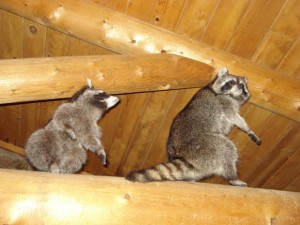Raccoons are not small. In fact, they can easily weigh up to 20 pounds. They are also incredibly intelligent and use their paws like hands. They have been known to open doors, jars, lids, windows, and even hatches. Thanks to this large body mass and dexterity, they can do a lot more damage to your home than a smaller animal like a mouse or squirrel.
Raccoons And Soffits
Raccoons seem to enjoy making dens in chimneys and attics. Their point of entry is soffits and they are not afraid to chew their way through. There are several reasons that raccoons find soffits an easy target. Soffits are generally located in low-traffic areas of the home. Many times, raccoon-induced damage may go unnoticed for quite a long time. In fact, by the time you see it, your raccoon may have multiplied! Soffits also are warm with dry air, which is very enticing to a raccoon. They also are usually easy to reach and easy to pry open for dexterous raccoons. Soffits are also generally protected from weather.
What To Do If Raccoons Move In And Raccoon-Proofing Your Home
So, a raccoon chewed through your soffit and moved into your home. The first thing you have to do is have the raccoons removed. You should not try to remove these creatures on your own. Without meaning to, you could endanger yourself or the raccoons. You could even be in violation of a local wildlife removal ordinance. You should start by calling a trained wildlife removal professional like Attic Solutions who are familiar with humane and effective raccoon removal procedures. You do not want to try to separate a mother raccoon from her kits. You might not live to tell about it! Once your raccoon family is humanely evicted, you need to seal and secure all points of entry. Sturdy, hardware wire mesh is usually adequate, although metal bars or panels also work depending on the design of your soffit. Just be sure to fix it properly so another unwelcomed guest doesn’t try to move back in.



